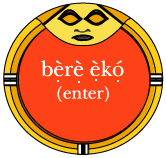
|
ABOUT
YORÙBÁ LANGUAGE AND PEOPLE
The Yoruba language is spoken natively by about thirty million people Nigeria and in the neighboring countries of the Republic of Benin and Togo. It is a Kwa language, which belongs to the Yoruboid group under the Niger-Congo phylum. One of the effects of the large number of Yoruba speakers and their geographic spread is the emergence of geography-bound linguistic variations among the speakers. Yoruba is a dialect continuum including several distinct dialects (Bamgbose (1966)). Estimates of the total number of Yoruba dialects vary from twelve to twenty-six (Ojo (1977), Adetugbo (1982), Oyelaran (1970, 1992), Mustapha (1987), Ojo (2001). The differences inherent in these dialects are marked in the areas of pronunciation, grammatical structure and vocabulary. A consensus standard form has however evolved and is recognized as the form for writing and teaching the language. It is understood by speakers of all the different dialects and it continues to serve the communicative purpose of all speakers. The language has been written since as early as 1800, although there have been many changes in aspects of its orthographic representation. Christian missionaries were the pioneers in the documentation of the language. The earliest publication in the language was in 1819 when Bowdwich produced the first known Yoruba word list containing only numerals. These efforts were largely amongst the free slaves in Sierra Leone, most of which had formed a Yoruba community in Freetown. Other publications followed and by 1849, Samuel Ajayi Crowther, a freed slave and minister, had published the grammar and dictionary of the language. This was a first of its kind amongst West African languages. The continued publication of materials such as the bible, church documents, newspapers, grammars and newspapers in Yoruba, particularly among Yoruba Christian missionaries, led to the standardization of the orthography in 1875 largely by the Church. In the 1960s through the 1970s, various orthography committees were set up, by both government and academic groups, to consider and subsequently review the standard orthography for the language. Significant reviews were done based on the report of the orthography committee in 1966. It is primarily the basis for the creation and introduction into schools of the standard Yoruba orthography and hence for the standard Yoruba language. The standard form of Yoruba is the type of Yoruba learned at school, and spoken (or written) mostly by educated native speakers to addressees who speak different dialects (Bamgbose (1966)). |
© African Studies Institute, University of Georgia
